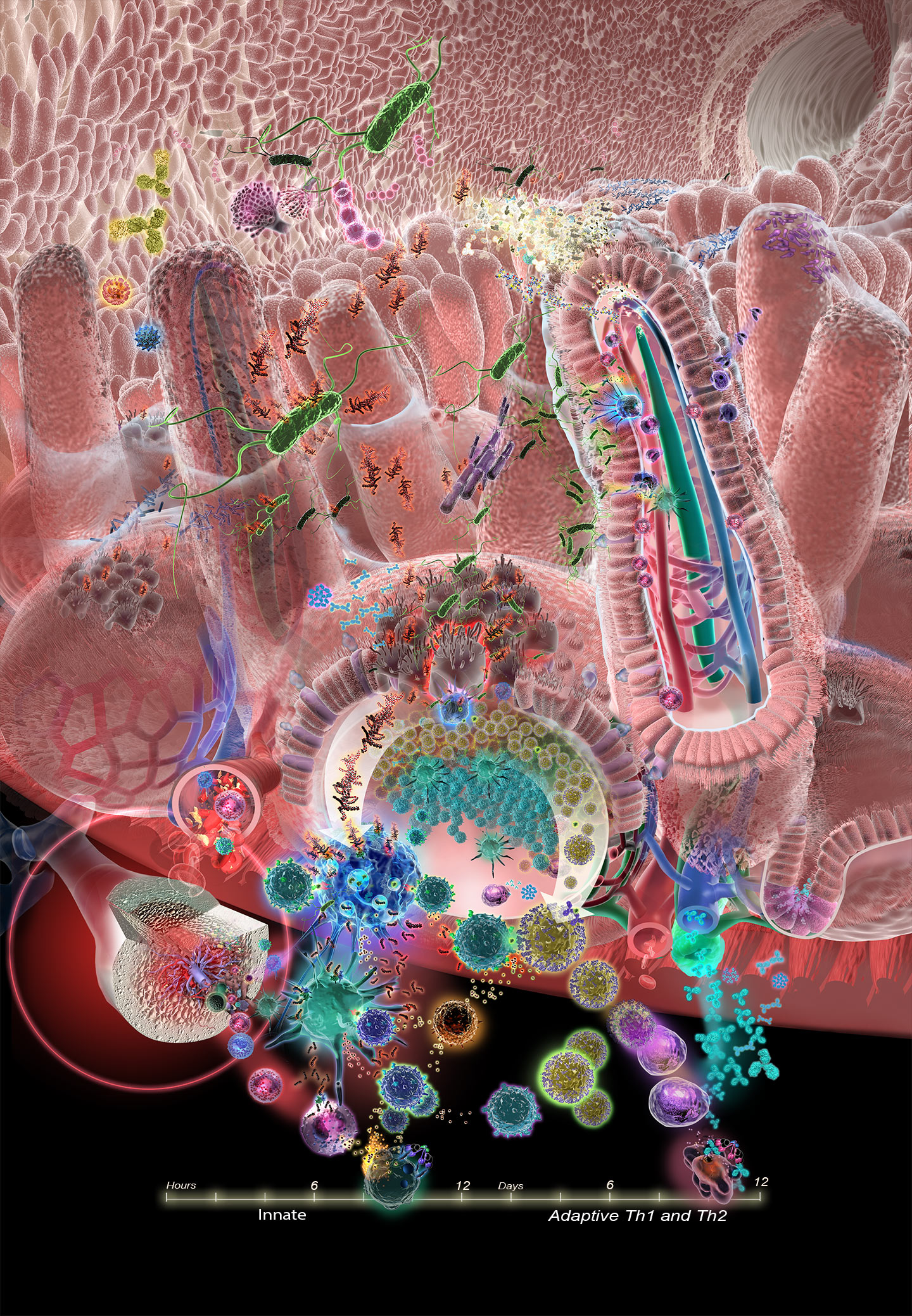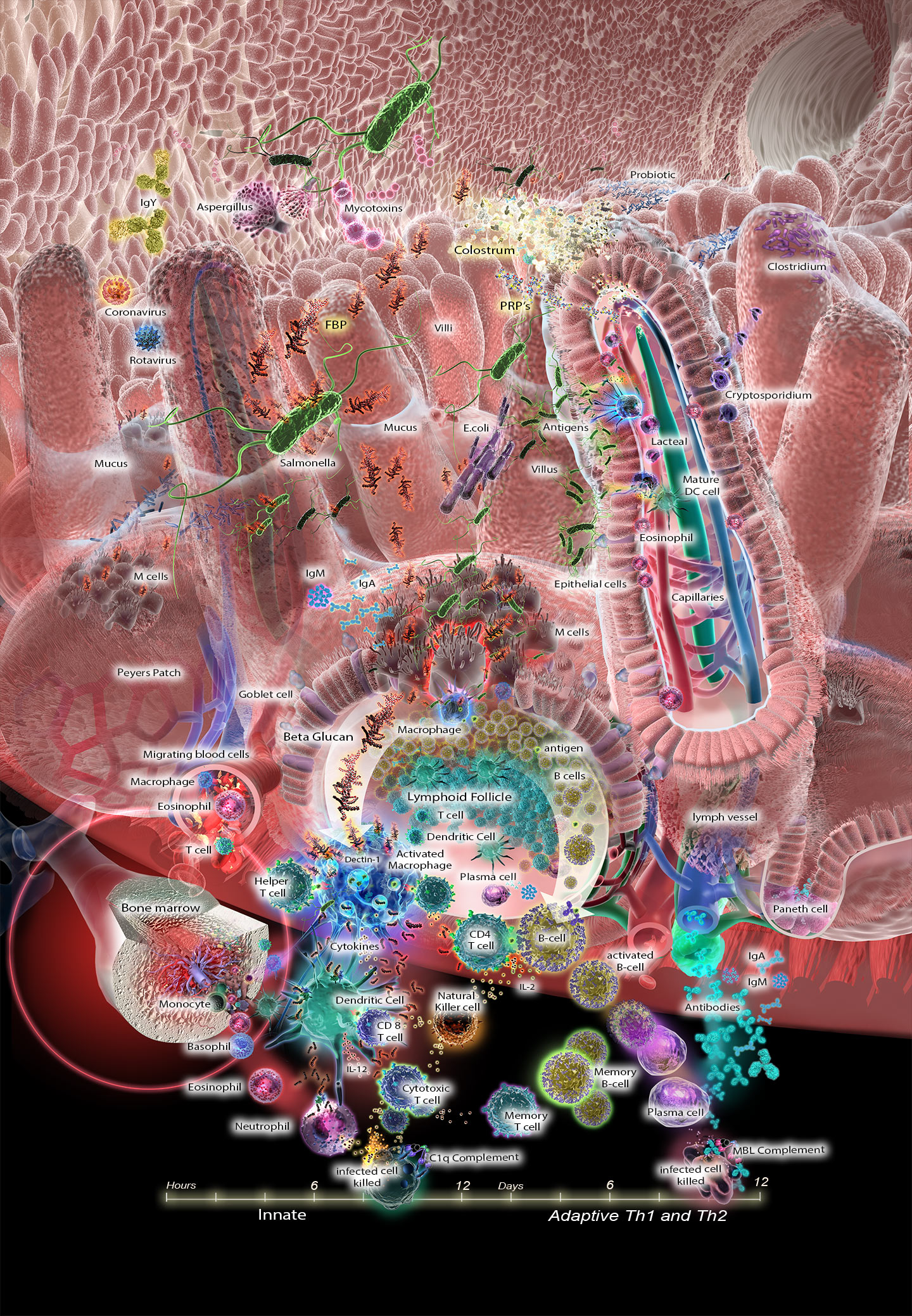Why a Balanced Digestive System is so Important for the Health of your Horse
Scientists have long known that a large portion of a horse’s immune system resides within the digestive tract, home to both good and bad bacteria. Maintaining microbial balance within the digestive tract is crucial in establishing gut health. Many horses experience discomforts ranging from gastro distress to colic, ulcers and bleeding. The commonality with these problems is that inflammation abounds and gut integrity is compromised. Smooth Run Equine’s patented digestive blend and colostrum works directly in the gut to reduce inflammation, promote epithelial growth and repair, improve nutrient absorption and promote colonization of the digestive tract by beneficial flora, effectively supporting gut health and gut immunity.
Why a Balanced Immune System is so Important for the Health of your Horse
Every second of the day your horse is waging a silent war against billions of viruses, bacteria, pathogens and parasites. Their immune system faces many challenges: stress, pollution, allergens, nutritional deficiencies, free radicals, surgery and medication. These challenges attack the host, acute and chronic illness weaken their immune system and their ability to recover. Without a primed and effective immune system your horse’s health is in serious jeopardy and they are vulnerable to disease. Do not underestimate the importance of maintaining a strong and healthy immune system. An immunoregulator is any substance that can quiet or activate the immune system, depending on circumstances. IPS supports the immune system to stay primed and strike the perfect balance between over activity and sluggishness. We need to realize the tremendous healing powers available in nature and harness them in the correct balance.
Learn how our supplements support digestive health and balance the immune system in the illustration of the gut lining
 Immunoglobulin (IgY)
Immunoglobulin (IgY)
Immunoglobulin (IgY)
IgY is found in high concentration in chicken egg yolk and is a class of proteins formed by the immune system in reaction to certain foreign substances and binds to them.
Aspergillus
Aspergillus species are highly aerobic and are found in almost all oxygen-rich environments, where they commonly grow as molds.
Mycotoxins
Are a toxic secondary metabolite produced by organisms of the fungi kingdom commonly known as molds.
Colostrum
Colostrum is a combination of vitamins, minerals and amino acids that are naturally occurring in a perfect combination. Colostrum is a rich source of both essential and non-essential amino acids, as well as essential fats, including phospholipids, which enable colostral protein protection and easy absorption in the gut by forming liposomes around them. Colostrum contains immune cells and many antibodies such as IgA, IgG, and IgM. These are all major components of the adaptive immune system.
<strong><u> </u></strong>
Probiotic
Probiotics are the beneficial bacterial inhabitants of our digestive tract. The term “probiotic” was coined to describe the deliberate ingestion of health promoting microorganisms.
PRP’s
Proline-rich Polypeptides are an immune component found in colostrums. PRP’s are short chains of amino-acids, the building blocks of proteins, but without the complex tertiary structure of proteins. PRP’s are signaling molecules that have the unique ability to modulate the immune system, turning it up when needed to fight an infection, or turning it down when it is overactive, i.e. in autoimmune disorders.
Coronavirus
Coronavirus are enveloped viruses and primarily infect the upper respiratory and gastrointestinal tract of mammals and birds.
Rotavirus
Rotavirus is a contagious virus that can cause gastroenteritis (inflammation of the stomach and intestines). Rotavirus infects young of many animal species.
Villi
Villi are small, finger-like projections that protrude from the epithelial lining of the intestinal wall. Villi increase the internal surface area of the intestinal walls which increases the surface area available for absorption.
Cryptosporidium
Crytosporidium is a microscopic parasite that causes diarrheal disease crytosporidiosis, commonly known as “Crypto”. This parasite can be spread in several different ways, but water is the most common method of transmission.
E.coli
E.coli is a gram-negative, rod shaped, facultative anaerobe bacterium and is commonly found in the lower intestine of warm-blooded organisms.
Antigens
An antigen (Ag), abbreviation of antibody generator, is any structural substance which serves as a target for the receptors of an adaptive immune response.
Lacteal
Lacteal lymph vessel is one of many central intestinal capillaries in the villi of the small intestine.
M cells
M cells are found in the special epithelium covering a Peyer’s patch and their function is to sample the antigen directly from the lumen and deliver it to antigen-presenting cells; T cells, B cells and memory cells are them stimulated upon encountering the antigen.
IgA
IgA is an immunoglobulin found in colostrum which serves as a first line of defense, protects mucosal surfaces and prevents the attachment of pathogens.
Epithelial cells
Epithelial cells form of cells that line the cavities in the body and also cover flat surfaces.
Eosinophil
Eosinophils are white blood cells and one of the immune system components responsible for combating multicellular parasites and certain infections in vertebrates. Along with mast cells they also control the mechanisms associated with allergy and asthma.
Peyers Patch
These regions of lymphoid tissue are found in the final section for the small intestine. Their function is to defend against infections in the intestines where large numbers of pathogenic microbes are found. Peyer’s patches establish their importance in the immune surveillance of the intestinal lumen and in facilitating the generation of the immune response within the mucosa
Beta Glucan
Beta Glucan is a polysaccharide polymer derived from the cell wall of mushrooms. Research has shown that beta glucan effectively strengthen the immune system by activating the white blood cells to support a healthy and robust immune response without over-stimulating it. MBG’s enhance the immune response by activating the macrophages, our body’s frontline of defense. MBG’s are the key to triggering the macrophages which starts the cascading effect of signaling the body there are invaders and calling on the cells to response.
Macrophage
Macrophages, the body’s frontline of defense. These cells of the immune system are responsible for finding, identifying and consuming foreign invaders in the body. Macrophages also have the ability to trigger other components of the immune system such as; Neutrophil, Eosinophils and Basophisl, B cells, T cells and Natural Killer (NK) cells
B cells
Cytokines secreted by certain T cells help B cells to multiply and mature into antibody production plasma cells make antibodies which circulate and bind to the antigens. They also remember the invader establishing an adaptive immune response.
T cell
T cells are highly specialized defender cells, different types of T cells are triggered by specific invaders such as, bacteria, viruses or parasites. Once recognized the T cells will quickly multiply creating an army of identical cells to fight the infection.
Dendritic Cell
Dendritic cells are antigen- presenting cells. Their main function is to process antigen material and present it on the cell surface to the T cells of the immune system. They act as messengers between the innate and the adaptive immune systems.
Cytokines
Some T cells will send chemical instructions called cytokines to the rest of the immune system signaling the body to product the most effective weapons against the invaders. i.e. bacteria, viruses or parasites. Other types of T cells will recognize and kill virus-infected cells directly.
Basophil
Basophil is the least common of the white blood cells and response to many kids of inflammatory reactions such as allergic reaction and parasitic infections
Neutrophil
Neutrophil
are the most abundant type of white blood cells in mammals and form an essential part of the innate immune system. Neutrophils are formed from the stem cells in the bone marrow
Eosinophil
Eosinophils are white blood cells and one of the immune system components responsible for combating multicellular parasites and certain infections in vertebrates. Along with mast cells they also control the mechanisms associated with allergy and asthma.

